What is ML?
When we use it?
Samuel(1959): learn without being explicitly programmed
Tom Mitchell
For the checkers playing example the experience e, will be the experience of having the program play 10's of 1000's of games against itself. The task t, will be the task of playing checkers. And the performance measure p, will be the probability that it wins the next game of checkers against some new opponent.
Supervised learning, unsupervised learning
Others: Reinforcement learning, recommender systems
Official summary
What is Machine Learning?
Two definitions of Machine Learning are offered. Arthur Samuel described it as: "the field of study that gives computers the ability to learn without being explicitly programmed." This is an older, informal definition.
Tom Mitchell provides a more modern definition: "A computer program is said to learn from experience E with respect to some class of tasks T and performance measure P, if its performance at tasks in T, as measured by P, improves with experience E."
Example: playing checkers.
E = the experience of playing many games of checkers
T = the task of playing checkers.
P = the probability that the program will win the next game.
In general, any machine learning problem can be assigned to one of two broad classifications:
Supervised learning and Unsupervised learning.
Supervised learning
Data set of house prices
Linear fit
Or quadratic? -> use learning algo
Supervised learning, give data set as well as the answer,(predict the answer)
Regression problem:
Classification Example
One feature example: age
Features: age, tumour size to decide good or bad tumour
Our algo is expected to fit that line and decide whether its good or bad feature
Quiz, regression or classification
Explanation:
For problem one, I would treat this as a regression problem, because if I have, you know, thousands of items, well, I would probably just treat this as a real value, as a continuous value. And treat, therefore, the number of items I sell, as a continuous value. And for the second problem, I would treat that as a classification problem, because I might say, set the value I want to predict with zero, to denote the account has not been hacked. And set the value one to denote an account that has been hacked into. So just like, you know, breast cancer, is, zero is benign, one is malignant. So I might set this be zero or one depending on whether it's been hacked, and have an algorithm try to predict each one of these two discrete values. And because there's a small number of discrete values, I would therefore treat it as a classification problem.
So regression->continuous value; classification->discrete(binary even)?
Summary
Supervised Learning
In supervised learning, we are given a data set and already know what our correct output should look like, having the idea that there is a relationship between the input and the output.
Supervised learning problems are categorized into "regression" and "classification" problems. In a regression problem, we are trying to predict results within a continuous output, meaning that we are trying to map input variables to some continuous function. In a classification problem, we are instead trying to predict results in a discrete output. In other words, we are trying to map input variables into discrete categories.
Example 1:
Given data about the size of houses on the real estate market, try to predict their price. Price as a function of size is a continuous output, so this is a regression problem.
We could turn this example into a classification problem by instead making our output about whether the house "sells for more or less than the asking price." Here we are classifying the houses based on price into two discrete categories.
Example 2:
(a) Regression - Given a picture of a person, we have to predict their age on the basis of the given picture
(b) Classification - Given a patient with a tumor, we have to predict whether the tumor is malignant or benign.
Unsupervised learning
Dataset has no labels
Given data set, can you find the pattern?
Example: google news
Grouping news stories: same themed news grouped together
- DNA example: group different people with similar type of DNA
So, unsupervised ML finds pattern and group things together?
Applications
Clustering:
Organise computing clusters;
societal network analysis;
market segmentation;
astronomical data analysis
Cocktail party problem: voice overlapping, but people still ok with communication
Cocktail party algo
Sounds like 2 audio source: filter one of them out
OCTIVE, MTALAB
SVD
QUIZ
Summary
Unsupervised Learning
Unsupervised learning allows us to approach problems with little or no idea what our results should look like. We can derive structure from data where we don't necessarily know the effect of the variables.
We can derive this structure by clustering the data based on relationships among the variables in the data.
With unsupervised learning there is no feedback based on the prediction results.
Example:
Clustering: Take a collection of 1,000,000 different genes, and find a way to automatically group these genes into groups that are somehow similar or related by different variables, such as lifespan, location, roles, and so on.
Non-clustering: The "Cocktail Party Algorithm", allows you to find structure in a chaotic environment. (i.e. identifying individual voices and music from a mesh of sounds at a cocktail party).








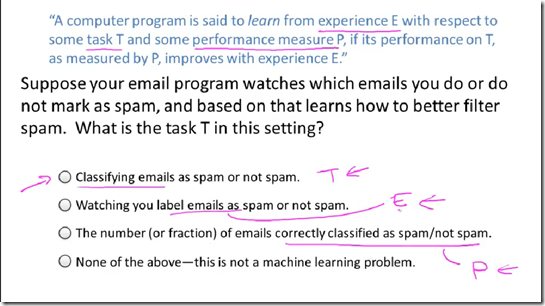
![clip_image001[5] clip_image001[5]](https://img-blog.csdn.net/20171229202011015)

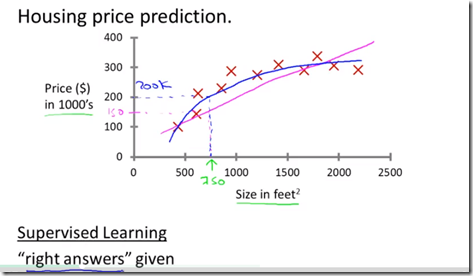
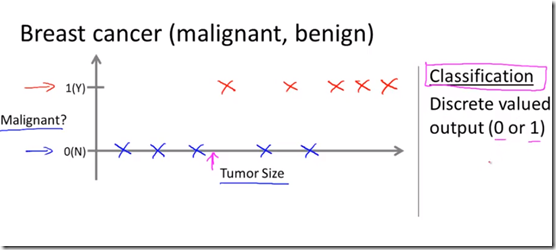
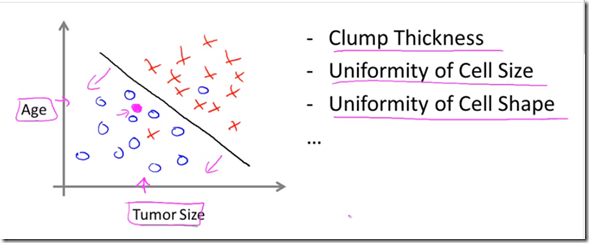
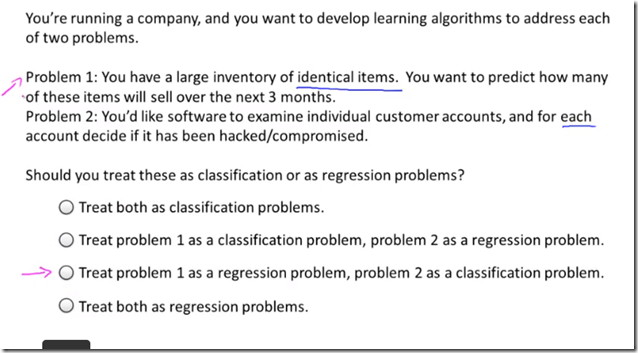
![clip_image001[7] clip_image001[7]](https://img-blog.csdn.net/20171229202035155)
![clip_image002[4] clip_image002[4]](https://img-blog.csdn.net/20171229202041573)














 753
753

 被折叠的 条评论
为什么被折叠?
被折叠的 条评论
为什么被折叠?








